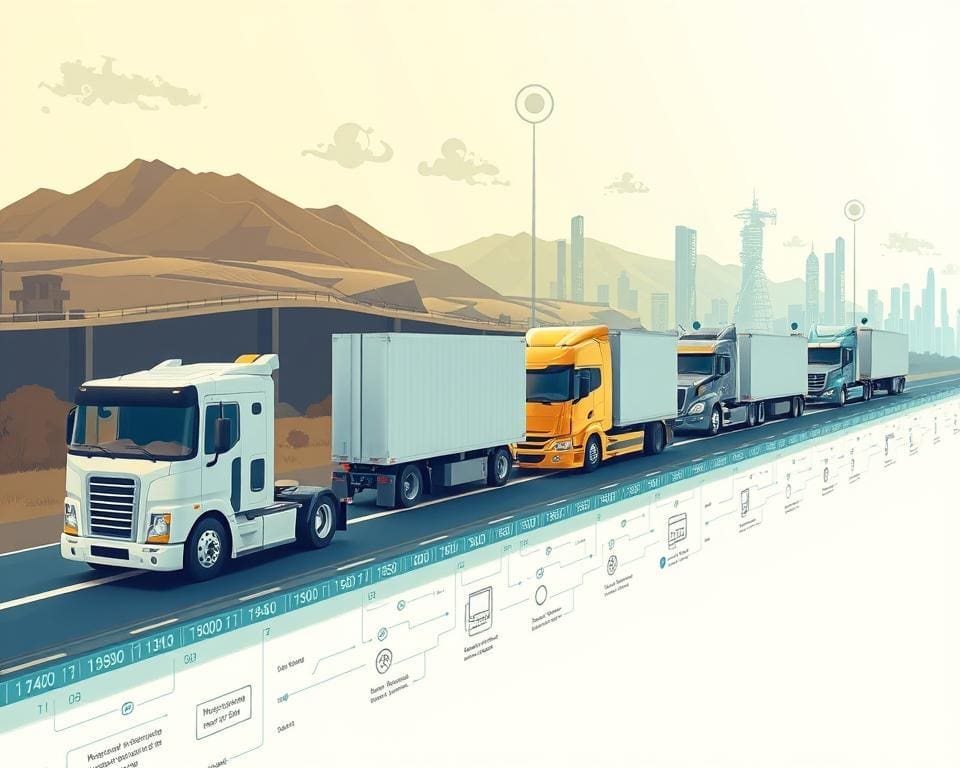The rise of trucks with AI marks a revolutionary transformation in the logistics industry, with self-driving trucks technology paving the way for a more efficient future. Major players such as Daimler and Volvo are at the forefront of this innovation, integrating advanced algorithms and sophisticated sensors into their vehicles. These technological advancements underpin the technology behind driverless lorries, enabling them to navigate with precision and interact seamlessly with existing traffic systems.
As we venture further into an era dominated by automation, it’s clear that the integration of AI-driven solutions could significantly reduce operational costs and elevate service efficiency. The implications extend beyond mere convenience, suggesting a potential reshaping of the entire freight sector, where logistics operations could become predominantly automated.
The Evolution of Self-Driving Trucks
The journey towards autonomous vehicles innovation has been marked by significant advancements that have reshaped the landscape of transportation. The evolution of self-driving trucks can be traced through several historical milestones that highlight the relentless pursuit of automation in logistics and transport.
Historical Milestones in Autonomous Vehicle Development
The concept of self-driving vehicles first emerged in the 1920s with conceptual ideas on road navigation. Over the decades, developments were sporadic until a notable surge began in the late 20th century. One of the most crucial milestones occurred in 2009 when Google unveiled its first prototype, significantly accelerating research and investment in automated driving technologies. Establishing partnerships between tech innovators and logistics companies marked a new era, creating a synergy that propelled autonomous vehicles further into the mainstream.
Current Trends in Automated Driving Systems
In recent years, current trends in automated driving systems have taken centre stage, showcasing advancements in sensor technologies and computer vision. Legislative frameworks now support the integration of self-driving technologies on public roads, promoting a smoother transition toward ubiquity. Moreover, the application of artificial intelligence is enhancing route optimisation and traffic management, fostering efficiency. Logistic companies increasingly demonstrate interest in adopting automated solutions, signalling a transformative shift within the industry.

Understanding Artificial Intelligence in Lorries
The integration of artificial intelligence in lorries is revolutionising the trucking industry. Various AI technologies driving innovation are becoming indispensable tools that enhance both productivity and safety. From sophisticated algorithms to cutting-edge sensors, these technologies allow for unprecedented levels of automation, creating safer and more efficient logistics operations.
Key AI Technologies Driving Innovation
Among the AI technologies driving innovation, several key components stand out:
- Neural Networks: These systems mimic human brain functions, enabling lorries to make real-time decisions by processing vast amounts of data.
- Computer Vision: Utilised for object detection and navigation, this technology allows lorries to identify obstacles in their path and respond effectively.
- Natural Language Processing: This technology facilitates communication between drivers and AI systems, enhancing user experience and operational efficiency.
Machine Learning and Its Role in Truck Performance
Machine learning in trucking plays a crucial role in improving truck performance. By harnessing data from previous routes and driving conditions, these systems can predict maintenance needs, optimise fuel consumption, and adapt driving strategies. This predictive capability enhances overall efficiency and leads to significant cost savings. The ongoing evolution of machine learning in trucking highlights its potential not just for performance enhancement but for reshaping operational paradigms.
Trucks with AI: Tech Behind Self-Driving Lorries
The integration of advanced technologies in the realm of AI-powered trucks marks a transformative shift in the logistics industry. The technology behind driverless lorries relies heavily on sophisticated systems that enable vehicles to navigate autonomously while ensuring safety and efficiency. Central to this evolution is advanced driver-assistance systems (ADAS), which encompass a range of features designed to enhance the driving experience, from adaptive cruise control to lane-keeping assistance.
Lidar technology plays a crucial role in the perception capabilities of self-driving trucks technology. By using laser beams to create detailed 3D maps of the environment, these systems detect obstacles and interpret road conditions with remarkable precision. Coupled with high-definition GPS navigation systems, AI-powered trucks can chart optimal routes in real time, significantly reducing transit times while minimising fuel consumption.
Furthermore, high-definition mapping and sensor fusion are pivotal in seamlessly transitioning from human to automated driving. These technologies provide a comprehensive view of the truck’s surroundings, ensuring that data from various sources is integrated to make informed driving decisions. This intricate interplay not only enhances the safety of AI-powered trucks but also streamlines operations, boosting productivity across the logistics network.
As the industry embraces these cutting-edge innovations, the potential of self-driving trucks technology to reshape freight transport becomes increasingly evident. With each advancement, the promise of a safer, more efficient transportation landscape draws nearer.
Smart Logistics Solutions Enabled by Autonomous Vehicles
The integration of autonomous vehicles into logistics presents transformative opportunities for the industry. As businesses adapt to this emerging technology, they unlock a myriad of smart logistics solutions that enhance overall operational efficacy.
Enhancing Supply Chain Efficiency with AI Technology
AI technology plays a pivotal role in boosting supply chain efficiency. Autonomous vehicles streamline operations, resulting in:
- Reduced delays in transportation routes
- Improved inventory management
- Enhanced real-time decision-making
These advancements not only optimise logistics but also significantly lower operational costs. By employing predictive analytics, companies can better anticipate demand, ensuring that resources are allocated effectively. As a result, the utilisation of smart logistics solutions becomes critical in navigating the complexities of modern supply chains.
Case Studies of Successful AI Integration in Logistics
Examining notable case studies AI integration in logistics sheds light on the tangible benefits derived from this technology. Amazon has adopted autonomous delivery systems that have led to remarkable reductions in delivery times. Walmart has similarly explored AI-driven trucks, realising notable savings in transportation costs. These examples illustrate how leading companies harness smart logistics solutions to enhance operational performance and meet consumer expectations. Data-driven approaches facilitate new levels of responsiveness, shaping a more efficient logistics landscape.
Safety Features of AI-Powered Trucks
As technology evolves, the emphasis on safety features of AI-powered trucks has risen significantly. These autonomous vehicles are designed with systems capable of detecting and responding to various hazardous situations, ensuring the wellbeing of drivers and other road users alike.
How Autonomous Vehicles Handle Hazardous Situations
AI-powered trucks utilise sophisticated sensors and advanced algorithms to identify potential dangers on the road. This includes:
- Collision avoidance systems that alert trucks to obstacles in their path.
- Adaptive cruise control, which adjusts speed to maintain safe distances from other vehicles.
- Emergency braking features that activate in moments of imminent danger.
These systems play a pivotal role in minimising risks. By reacting swiftly to unexpected changes in the environment, these vehicles significantly enhance road safety.
The Importance of Real-Time Data Processing
Real-time data processing underpins the effectiveness of the safety features AI-powered trucks offer. The ability to analyse vast amounts of data instantly allows these vehicles to make informed decisions that directly affect safety. Key points about real-time data include:
- Risk assessment, where algorithms meticulously evaluate potential hazards.
- Predictive capabilities that foresee possible dangerous scenarios based on current data.
- Seamless communication among multiple trucks and infrastructure to improve overall traffic safety.
Through these innovations, AI-powered trucks not only aim to safeguard their own operations but also contribute to the overall safety of road traffic. As the industry develops further, adherence to safety regulations will ensure the reliable implementation of these advanced technologies.
The Future of Automated Driving Systems
The landscape of transportation is on the brink of transformation, driven by the future of automated driving systems. As engineers and technologists push the boundaries, these advancements in self-driving technology promise to redefine how goods are moved. From enhanced vehicle autonomy to significant improvements in safety features, the journey towards fully automated trucks is gaining momentum.
Predicted Advancements in Self-Driving Technology
Innovations in artificial intelligence and machine learning are expected to lead the charge in the realm of self-driving technology. Autonomous vehicles will likely incorporate advanced sensors and real-time processing capabilities, fostering an era where trucks can navigate complex environments with minimal human intervention. Future iterations may offer:
- Increased levels of vehicle autonomy, leading to reduced reliance on human drivers.
- Enhanced communication systems between vehicles and smart infrastructures.
- Improved algorithms for decision-making in various driving conditions.
Potential Impacts on Employment and the Economy
The shift towards automated driving solutions carries profound implications for the workforce and the economy. The impacts on employment and economy may encompass:
- Changes in the labour market, where traditional driving roles may decline as automation becomes commonplace.
- New job opportunities in sectors related to technology development, maintenance, and support for these systems.
- Influences on service demand within the transportation sector, potentially leading to decreased transportation costs and increased efficiency.
As the future of automated driving systems unfolds, it will be essential for stakeholders to engage in meaningful dialogues. Navigating the societal challenges of job displacement and safety concerns will require concerted efforts from policymakers, industry leaders, and the public alike.
Challenges in Implementing Self-Driving Trucks
As the quest for automated transport continues, the challenges in implementing self-driving trucks become increasingly pronounced. One of the primary obstacles to autonomous vehicles lies in achieving full automation across diverse driving conditions. The technology must robustly interpret various environment inputs while ensuring safe operation, which remains a technical hurdle many are striving to overcome. It is essential for developers to refine their algorithms and sensors to address these intricacies, pushing the boundaries of what is possible in the realm of transportation.
Equally critical is the need for comprehensive cybersecurity measures. The potential vulnerabilities in autonomous systems pose significant threats that need to be effectively managed. A breach in security could lead to disastrous consequences, affecting not only the vehicles themselves but also the broader logistics ecosystem. Thus, ensuring the safety and security of data information is fundamental in building trust as we tread further into the era of AI-powered transport.
Another pressing matter surrounds public sentiment and regulatory frameworks, which must evolve alongside technological advancements. Many stakeholders are grappling with skepticism regarding the safety and reliability of self-driving trucks, and alongside this, complex regulatory challenges arise. Engaging with the public and creating robust policies that foster understanding are pivotal in alleviating fears and building confidence in these transformative technologies. A collaborative approach involving technology providers, government agencies, and industry leaders is necessary to navigate the multifaceted challenges in implementing self-driving trucks and realise the benefits they present.









